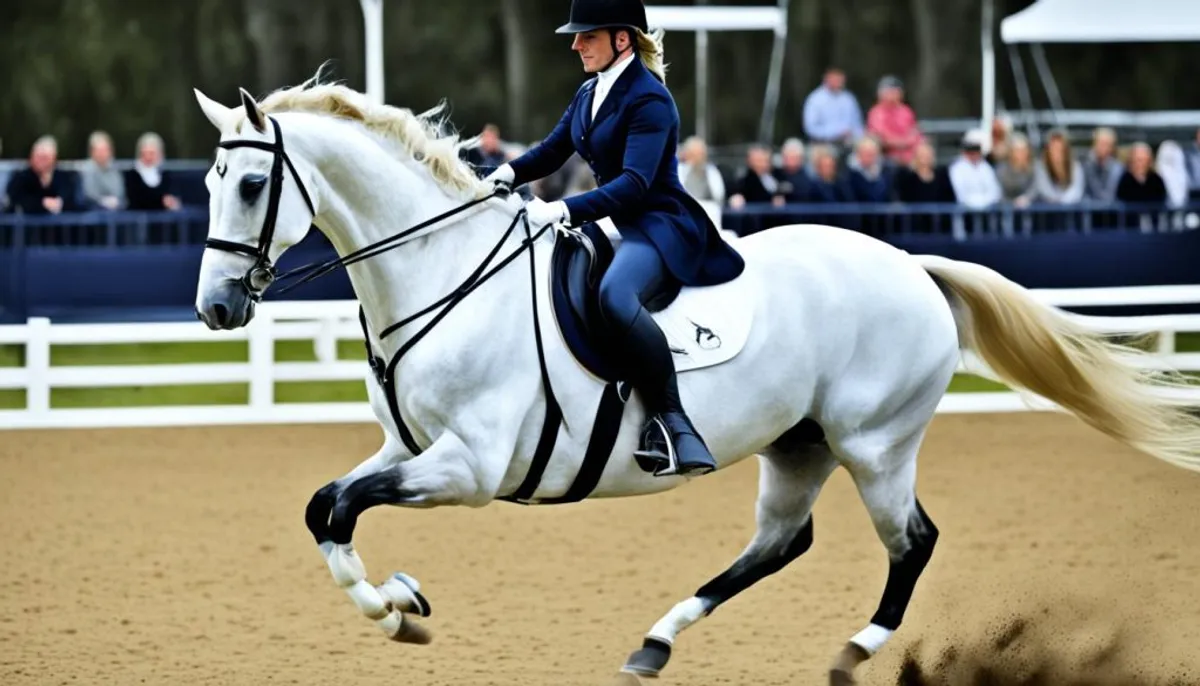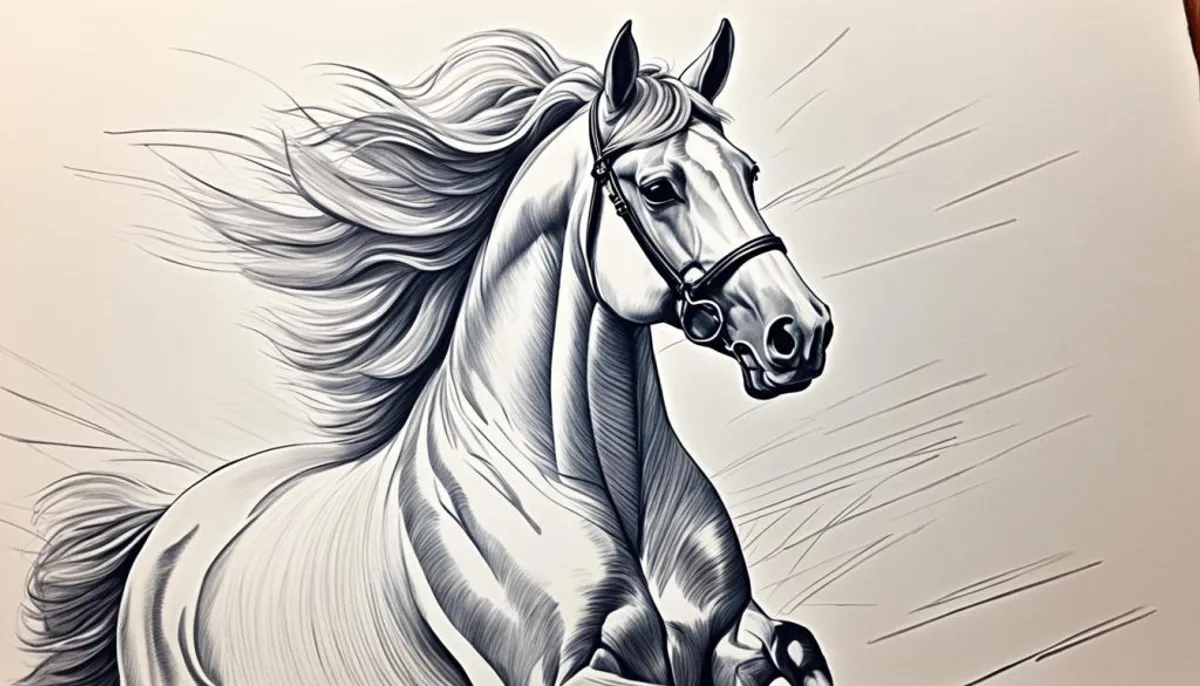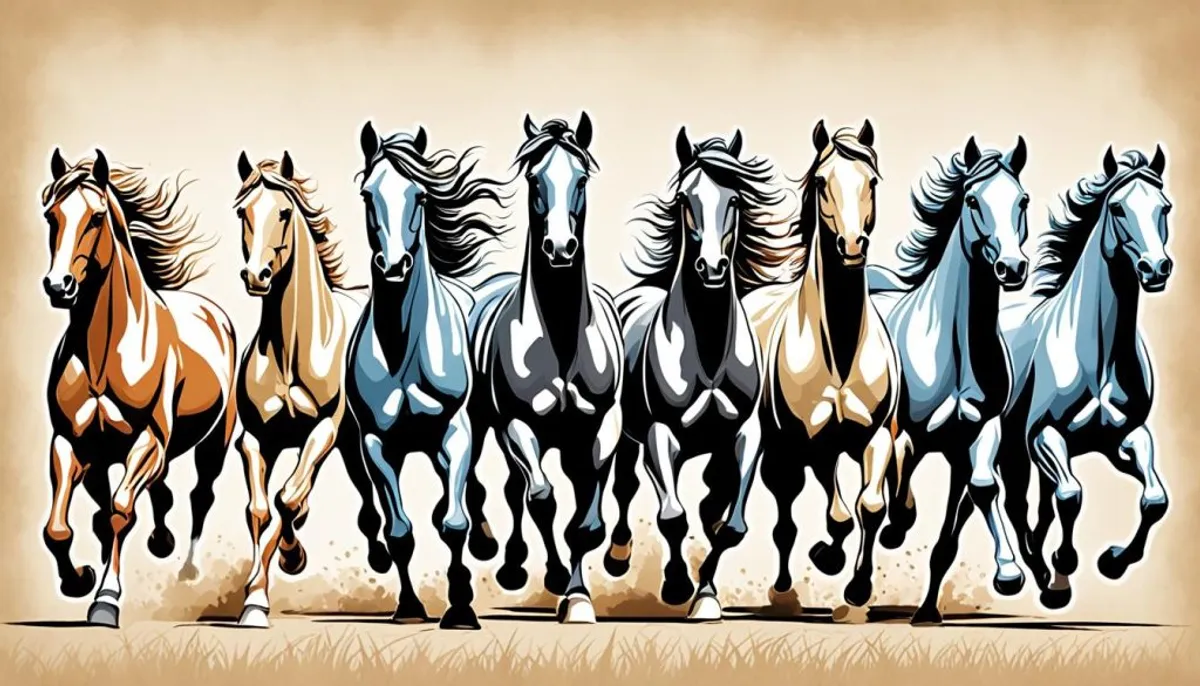Are you passionate about horses and drawing? “The Art of Drawing Horses” is the perfect book for you. It explains step by step how to draw horses, whether you are a beginner or an expert. This guide teaches you to translate the beauty and strength of horses onto paper.

Main Takeaways
- Discover the fundamental techniques of equestrian drawing, from necessary materials to anatomical basics
- Practice through hands-on exercises and models to refine your skills
- Benefit from expert advice to overcome the complex challenges of horse drawing
- Find other complementary resources such as recommended books and blogs
- Develop your creativity and artistic sense in the representation of horses
Introduction to the Art of Equestrian Drawing
Equestrian drawing is truly captivating. It allows you to visualize the beauty of horses. To achieve this, one must understand their anatomy and movements.
The Importance of Representing Horses
Learning to represent horses is key for artists. These splendid creatures are a rich and challenging subject. Being able to draw them realistically is a significant advantage, whether for competition scenes or other unique moments.
Overview of the Book “The Art of Drawing Horses”
The book “The Art of Drawing Horses” is perfect for anyone looking to improve. It offers a clear method for drawing them well. It includes tips on anatomy and technique.
This guide also includes practical exercises. It is a treasure for enthusiasts of equestrian drawing.
The Essential Materials for Equestrian Drawing
Diving into equestrian drawing requires the right materials. To capture the beauty of horses or enhance your skills, the right tools are necessary. Here’s what you need to know about the ideal equestrian drawing materials to get started.
Among the essentials for drawing horses, here’s what you need:
- Pencils of various hardness (HB, 2B, 4B, 6B) to play with shades
- Various erasers (kneaded, gum) to erase and refine your drawings
- Choose quality paper with a light grain, as it provides a nice texture for drawing
- Use fixative to protect your works
- Tools like sharpeners, rulers, and a sketchbook will make your workspace practical
In addition to the essentials, consider these specific tools:
- Watercolor pencils, ideal for adding color
- Colored pencils, perfect for detailed work
- An easel or an inclined surface will enhance your comfort
- A portable support for drawing wherever you are
With this complete equestrian drawing material, you will be ready to draw the beauty of horses. Don’t forget to explore to find the tools that will highlight your horse drawing style.
| Tool | Use |
|---|---|
| Pencils | Varying effects of values and textures |
| Erasers | Blending and correcting drawings |
| Quality paper | Allows for better pencil grip |
| Fixative | Protect and set finished drawings |
| Accessories | Organize the workspace |
Understanding Fundamental Techniques
Learning drawing techniques is crucial for drawing horses well. This book presents keys such as shading and value scale. It also explores the basics of horse anatomy, including their morphological structure and how to draw coats, eyes, and hooves.
Shading and Value Scale
Shading and value scale add realism to horse drawings. You will learn to play with light and shadow. Thus, your drawings will appear lively and deep.
Basic Anatomy of Horses
Knowing the anatomy of horses is essential for accurate drawing. This book covers the morphological structure and how to properly draw coats, eyes, and hooves. Once mastered, these basics will allow you to capture the essence of the horse.
| Technique | Description | Example |
|---|---|---|
| Shading | Mastery of light and shadow degrees to create volume |  |
| Value Scale | Using a range of tones to represent value nuances | |
| Horse Anatomy | Knowledge of the morphological structure for precise drawing |
Practicing with Exercises and Models
To become good at equestrian drawing, you need to practice a lot. A book can show you equestrian drawing exercises. It also includes horse models to guide you step by step. By doing these exercises, you will improve your techniques and skills.
Each exercise takes just 15 minutes. This means you can practice often without wasting too much time. By drawing the models, you will learn all about the horse's body.
- Exercise 1: Quick sketch of a galloping horse
- Exercise 2: Study of the horse's proportions from the front
- Exercise 3: Drawing a horse in different positions
- Exercise 4: Representation of the coat and mane
- Exercise 5: Sketch of a working horse
The equestrian drawing exercises are varied. They help you master the drawing techniques. You will learn to draw horse models in all forms.
Feel free to do them often to improve your equestrian drawing.
| Exercise | Duration | Level |
|---|---|---|
| Quick sketch of a galloping horse | 15 minutes | Intermediate |
| Study of the horse's proportions from the front | 15 minutes | Beginner |
| Drawing a horse in different positions | 15 minutes | Advanced |
| Representation of the coat and mane | 15 minutes | Intermediate |
| Sketch of a working horse | 15 minutes | Advanced |
With these equestrian drawing exercises and horse models, you will see great improvement. You will become better at drawing and can depict horses in any way.

Professional Tips for Equestrian Drawing
Drawing horses is a challenge, but also very rewarding. The authors of “The Art of Drawing Horses” have gathered tips from professionals. These equestrian drawing tips will help you progress in your art.
Overcoming Complex Difficulties
Drawing horses requires attention. You must understand their anatomy, movements, and consider proportions. However, the right tips can help you overcome these challenges:
- Start by learning the horse's anatomy, focusing on essential elements.
- Quick sketching allows you to capture the lively movements and postures of horses.
- It is crucial to manage shadows and highlights well. This brings life to your drawings.
- Patience and perseverance are essential. Your talent sharpens over time and practice.
By applying these equestrian drawing tips, you can push your artistic limits. Thus, you create impressive equestrian works.
Other Complementary Resources on Equestrian Drawing
Besides the book “The Art of Drawing Horses”, you will find other essential materials. They will enrich your skills in equestrian drawing. Here are specific books and blogs to improve your skills in this art.
Recommended Books
- “Horse Anatomy for Artists” by Julien Desailly – This guide teaches you horse anatomy in detail. It is crucial for creating realistic works.
- “Step-by-Step Horse Drawing” by Deb Kalas – This approach teaches you equestrian drawing step by step. You will start with simple postures and progress to advanced details.
- “Horses and Riders: Drawing Techniques” by Fabrice Cazenave – This book is filled with tips and techniques. It teaches you to capture the movement and energy of horses on paper.
Blogs to Follow
- Horse Passion – A rich source of information with tutorials, tips, and inspiration focused on equestrian drawing.
- Equiartist – A site dedicated to equestrian art, offering various articles and videos. These resources will help you progress in horse drawing.
- Equidraw – A blog offering a wealth of equestrian drawing resources, from techniques to interviews with renowned artists.
I encourage you to explore these various resources to enhance your skills. Happy reading and enjoy your creations!
Conclusion
This guide will help you learn equestrian drawing. You will be able to draw the beauty of horses. Whether you have just started or have been drawing for a long time.
Experts will give you tips. You will learn the basic techniques. Such as body shapes and adding shadows. You will be able to overcome challenges and create high-quality works.
Do you want to draw your favorite horses? Or maybe tournament scenes? This guide is here for you. It will help you develop your talent. Show the beauty of horses with your drawings.
FAQ
What is equestrian drawing?
Equestrian drawing captures the majesty of horses on paper. It is an art that pays tribute to the beauty and strength of these animals. Drawing these creatures requires talent and an artistic eye.
What does the book “The Art of Drawing Horses” contain?
The book describes a drawing method for those who love horses. It covers everything you need to know, from how to get started to choosing materials. Experts also provide useful tips.
What materials are essential for equestrian drawing?
The right materials make all the difference. The book recommends special pencils and other tools. This will ensure the quality of your horse drawings.
What are the fundamental techniques to master?
The book covers basic techniques such as shading and horse anatomy. You will learn how to draw important details of horses, like coats and eyes.
What exercises and models are proposed in the book?
15-minute exercises are available to you. By following them, you can improve your skills. These practical tasks are perfect for helping you progress.
What are the professional tips for overcoming challenges?
The publication offers advice from expert horse illustrators. They will help you overcome obstacles. With these tips, succeeding in your drawings will be easier.
What other resources are available to deepen equestrian drawing?
There are many other books and blogs to deepen your knowledge. If you really enjoy drawing horses, explore these resources. They will help you evolve in your practice.
RelatedRelated articles



